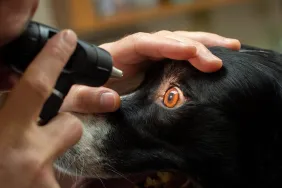Hemivertebrae in Dogs: Symptoms, Causes, & Treatments

Hemivertebrae in dogs is a medical condition that involves deformed vertebrae. Technically, the condition is also called butterfly vertebrae.
Unfortunately, the condition is congenital. This means a dog is born with it. The disorder causes a pup’s vertebrae to become shaped like a wedge, rather than a cylinder. Generally, the condition can cause problems with the way a pup walks. Unfortunately, in some cases a surgery is required to treat hemivertebrae in dogs.
If you see signs that your dog might be suffering from this condition, then you must consult your veterinarian for a proper diagnosis and course of treatment. Here’s what you should know about the symptoms, causes, and treatments of hemivertebrae in dogs.
Symptoms of hemivertebrae in dogs
Hemivertebrae in dogs can result in a range of symptoms. Generally, the symptoms depend on how many vertebrae are affected.
@media (min-width: 0px) and (max-width: 749px) { .pb_prebidjs_300x250_a__wrapper { min-height: 250px; } } @media (min-width: 750px) { .pb_prebidjs_300x250_a__wrapper { display: none; } }
For example, some of the most common symptoms include:
- Problems walking
- Pain
- Weak back legs
- Incontinence
Causes of hemivertebrae in dogs

The cause of the condition is congenital. This means a dog is born with it.
Generally, the following breeds are most likely to develop the disorder:
- Pug
- French Bulldog
- German Shorthaired Pointer
- English Bulldog
- German Shepherd
- Boston Terrier
Additionally, it is suspected that environmental factors play a part in cases of butterfly vertebrae. For instance, dogs that are exposed to toxic substances seem to be at higher risk of developing the disorder.
Treatments for the condition in dogs
If you think that your dog might be developing hemivertebrae, your veterinarian will want to carry out a full physical examination of your dog. Additionally, your vet will ask about your dog’s full medical history. This will include any breed-specific problems.
Generally, an X-ray can diagnose the condition. Additionally, MRIs and CT scans can also be used to confirm a case of hemivertebrae.
Usually, treatment will depend on your dog’s precise symptoms. For example, in some cases, no specific treatment will actually be needed. However, in other cases, anti-inflammatory medication can be prescribed.
As always, if your vet prescribes your dog any medication, follow the precise dose and frequency instructions. Also, make sure to complete the full course of medication.
Unfortunately, severe cases of the condition require a surgery. Technically, the procedure is called hemilaminectomy. This surgery removes any parts of the discs between the vertebrae that are pressing against the spinal cord.

Adolescent Dogs: What To Expect During Their Teenage Phase

Ketoconazole for Dogs: Uses, Dosage, & Side Effects

Why Your Dog Is Dragging Their Butt and Scooting

Spinal and Vertebral Birth Defects in Dogs: Symptoms, Causes, & Treatments

Scleritis in Dogs: Symptoms, Causes, & Treatments

Dog Vaccinations: What To Know About Your Pet’s Vaccines




